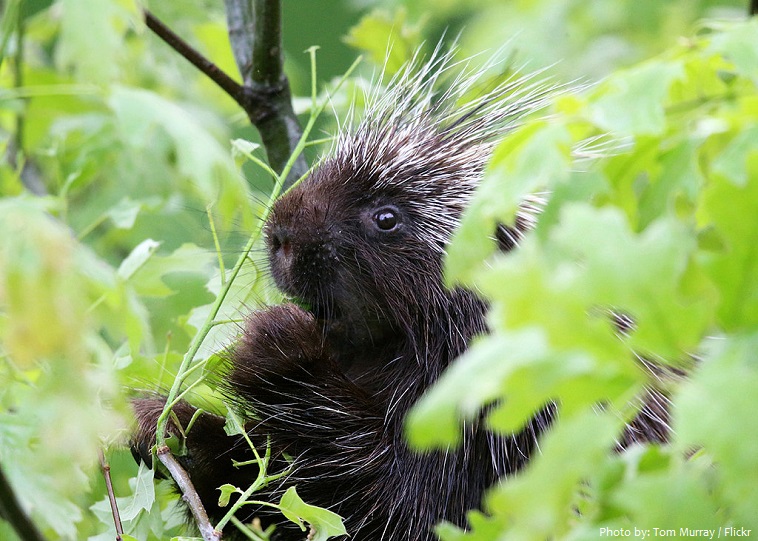

Male and female Cape porcupines are similar in size, with an estimated adult weight of 12–18 kg. Although they predominantly feed on plants, Cape porcupines have also been found to occasionally consume carrion, and they chew or nibble on bones in areas with deficient phosphorus levels – a condition called osteophagia. Additionally, in instances where their feeding time is not limited, they can consume about 1.5–2.7 kg of economically important agricultural crops per feeding session. Their eating habit is considered fairly destructive in the sense that they bite or dig up more vegetables storage organs than they eat. In grassland habitats, porcupines feed on the rhizomes, bulbs and geophytes of a variety of wild plant species. For example, porcupines inhabiting natural systems such as woodlands have been observed to feed on live tissues of the inner bark of mature trees and to uproot young trees. Cape porcupines are also considered generalist foragers, and they consume diverse types of food depending on their availability. They also feed on epigeal plant parts such as leaves, shoots, stems, tree barks and fruits. Their day-time shelter is thought to include rock crevices, caves and abandoned burrows or other types of holes, which they have excavated or modified to their own requirements.Ĭape porcupines are typically herbivorous, consuming mainly underground plant storage organs such as the bulbs, tubers and roots. In the south, they are found throughout most of the southern African sub-region (South Africa, Botswana, Lesotho, Eswatini, Zimbabwe and Namibia) but absent in most central parts of Botswana.Ĭape porcupines inhabit the savanna, subtropical or tropical dry shrublands and grasslands, artificial and/or terrestrial plantations, rural gardens and arable lands. They are found in Burundi, Kenya and in partS of southern Uganda, through Tanzania, Rwanda, southeastern Democratic Republic of Congo (DRC), in the extreme southwestern part of Congo, Angola, Zambia, Malawi and Mozambique. They communicate warning signs through stamping feet, raising quills and shaking the rattle quills on their tails.ĭue to their tolerance to various habitats, Cape porcupines are widely distributed, occurring throughout the southern African sub-region with exception to extremely arid areas such as the Namib Desert in Namibia. They also use tactile communication through a light touch or more aggressive physical contact for mating, competition or defense, as well as a chemical communication to scent-mark their feeding areas. They communicate vociferously through piping calls, grunting and snuffing noises. They are capable of digging but cannot climb or jump.Ĭape porcupines communicate in various ways depending on the situation. Females carry on average one litter each year during wet summer months with an interval of 365 days, and survivorship of juveniles is high irrespective of density.Ĭape porcupines walk slowly and shuffle but can run quickly when necessary.

The tail bears a rattle of hollow rattle quills, which are circular in cross-section but are hollow and open at the end and shaped like a capsule.Ĭape porcupines are monogamous and are reproductively active throughout the year. The quills are banded black and white at the back and the longer quills have multiple repeating black and white bands, with up to six white sections. The Cape porcupine’s body is covered with flattened bristly hairs, spines which are up to 50 cm long and stout quills that grow up to 30 cm long and erect for self-defence. Their ears are inconspicuous and shaped like human ears. They have small eyes that are situated far back on their heads. Their heads are rounded with greyish brown bristled faces and stout but mobile sensory hair. They are heavily built with short and well-bristled bodies, rather short legs, and short tails that are well hidden. Adult Cape porcupines weigh about 10.0–24.1 kg and are not sexually dimorphic, i.e., both males and females look the same.
:max_bytes(150000):strip_icc()/GettyImages-581746069-587cc9683df78c17b66e9bb1.jpg)
Hystrix africaeaustralis is one of the species described under this sub-genus, with two named subspecies ( Hystrix africaeaustralis africaeaustralis and Hystrix africaeaustralis zuluensis). They are hystricomorphs and nocturnal (i.e., they normally rest during the day in their burrows and forage at night). I know I walk slowly, be patient, don’t startle me because I might unleash my quills and spines on you.ĭescription/How to recognize a Cape porcupineĬape porcupines, also known as Old World porcupines, are the largest rodents from the sub-genus Hystrix and are native to southern Africa. Common names: South African crested porcupine (Eng.) Kaapse ystervark (Afr.) noko (Sepedi) nungu (Xitsonga) nungu (Tshivenda), ingungumbane (IsiZulu).


 0 kommentar(er)
0 kommentar(er)
